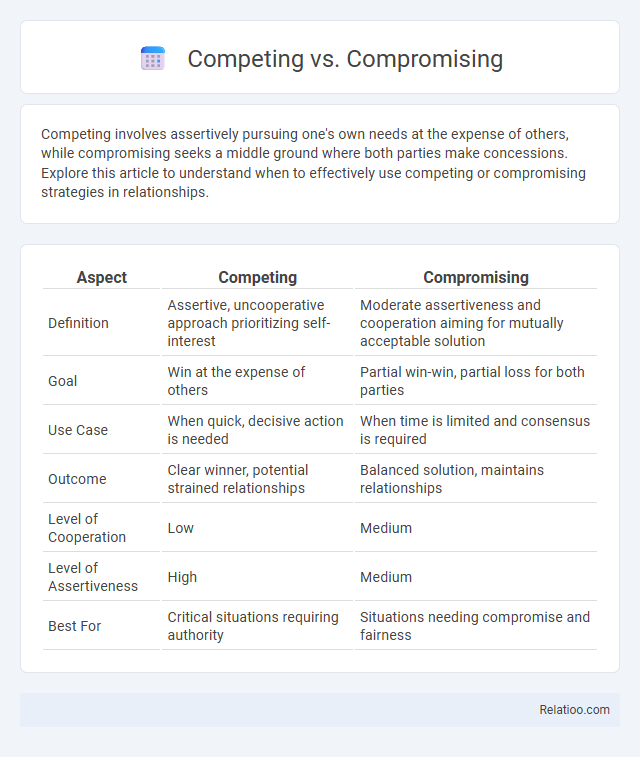Competing involves assertively pursuing one's own needs at the expense of others, while compromising seeks a middle ground where both parties make concessions. Explore this article to understand when to effectively use competing or compromising strategies in relationships.
Table of Comparison
| Aspect | Competing | Compromising |
|---|---|---|
| Definition | Assertive, uncooperative approach prioritizing self-interest | Moderate assertiveness and cooperation aiming for mutually acceptable solution |
| Goal | Win at the expense of others | Partial win-win, partial loss for both parties |
| Use Case | When quick, decisive action is needed | When time is limited and consensus is required |
| Outcome | Clear winner, potential strained relationships | Balanced solution, maintains relationships |
| Level of Cooperation | Low | Medium |
| Level of Assertiveness | High | Medium |
| Best For | Critical situations requiring authority | Situations needing compromise and fairness |
Understanding the Concepts: Competing and Compromising
Competing involves assertively pursuing your own goals at the potential expense of others, emphasizing win-lose outcomes often seen in high-stakes or urgent situations. Compromising requires both parties to make mutual concessions, aiming for a balanced solution that partially satisfies everyone, useful when quick, fair resolutions are needed. Understanding these conflict styles helps you navigate interpersonal dynamics by choosing the most effective approach based on context and desired results.
Key Differences Between Competing and Compromising
Competing involves assertively pursuing your own goals without yielding to others, often prioritizing winning over relationships, while compromising seeks a middle ground where both parties make concessions to reach an acceptable solution. Key differences between competing and compromising include the level of assertiveness and cooperativeness: competing is high assertiveness with low cooperativeness, whereas compromising balances both to achieve partial satisfaction for all involved. Understanding these distinctions helps you choose the most effective conflict resolution strategy based on the situation's demands.
When to Choose Competing in Conflict Resolution
Choose competing in conflict resolution when immediate, decisive action is necessary, such as in emergencies or situations where your rights or values are at stake. This assertive approach prioritizes winning the argument or achieving your goals over maintaining relationships, making it effective in high-stakes negotiations or when quick solutions prevent harm. Your ability to leverage authority and expertise ensures your position is upheld when compromise is not feasible or might undermine important outcomes.
Situations Ideal for Compromising
Compromising is ideal in situations where both parties need to find a middle ground quickly, such as resolving workplace disputes or negotiating deadlines. You benefit from compromising when maintaining relationships is important but a complete agreement is not essential, allowing for partial satisfaction of conflicting interests. This approach balances assertiveness and cooperation, making it effective for time-sensitive decisions and evenly valued goals.
Pros and Cons of a Competing Approach
The competing approach in conflict resolution emphasizes assertiveness and pursuing your goals, which can lead to quick decisions and clear outcomes. This method is beneficial in situations requiring decisive action or protecting vital interests but may damage relationships due to its confrontational nature. While competing can assert your position effectively, it risks creating resentment and reducing collaboration if overused.
Advantages and Disadvantages of Compromising
Compromising in conflict resolution offers the advantage of achieving a quick and mutually acceptable solution, preserving relationships by balancing both parties' interests. It facilitates cooperation and maintains harmony but may result in suboptimal outcomes since neither side fully satisfies their needs. The main disadvantage is that frequent compromising can lead to a pattern of settling for less, potentially fostering resentment or failing to address deeper issues.
Psychological Factors Influencing Conflict Styles
Psychological factors such as personality traits, emotional intelligence, and past experiences significantly influence whether someone favors competing, compromising, or patterned conflict styles. You may find yourself competing when motivated by assertiveness and a desire for control, while compromising often reflects a value placed on harmony and cooperation. Recognizing these internal drivers helps tailor conflict resolution strategies to your unique psychological profile.
Strategies for Balancing Competing and Compromising
Effectively balancing competing and compromising strategies in conflict resolution involves recognizing when to assert your interests firmly and when to seek middle ground for mutual benefit. You can identify scenarios where competition is necessary to protect core values or objectives while employing compromise to maintain relationships and foster collaboration. Developing this balance enhances decision-making by aligning assertiveness with empathy, optimizing outcomes for all parties involved.
Impact on Relationships and Team Dynamics
Competing often creates a win-lose scenario that can damage trust and reduce collaboration within teams, fostering a competitive rather than cooperative atmosphere. Compromising promotes partial satisfaction for all parties, which may maintain relationships but can lead to suboptimal solutions and reduced long-term commitment. Pattern conflicts, if unmanaged, embed recurring negative behaviors that erode team cohesion and hinder productive communication, ultimately impacting overall team dynamics and morale.
Developing Effective Decision-Making Skills
Understanding Competing, Compromising, and Pattern approaches enhances your decision-making skills by providing varied strategies tailored to different situations. Competing emphasizes assertiveness and quick resolution, while compromising seeks a balanced outcome that satisfies all parties moderately. Recognizing and applying these patterns allows you to make informed decisions that optimize results and maintain relationships effectively.

Infographic: Competing vs Compromising
 relatioo.com
relatioo.com